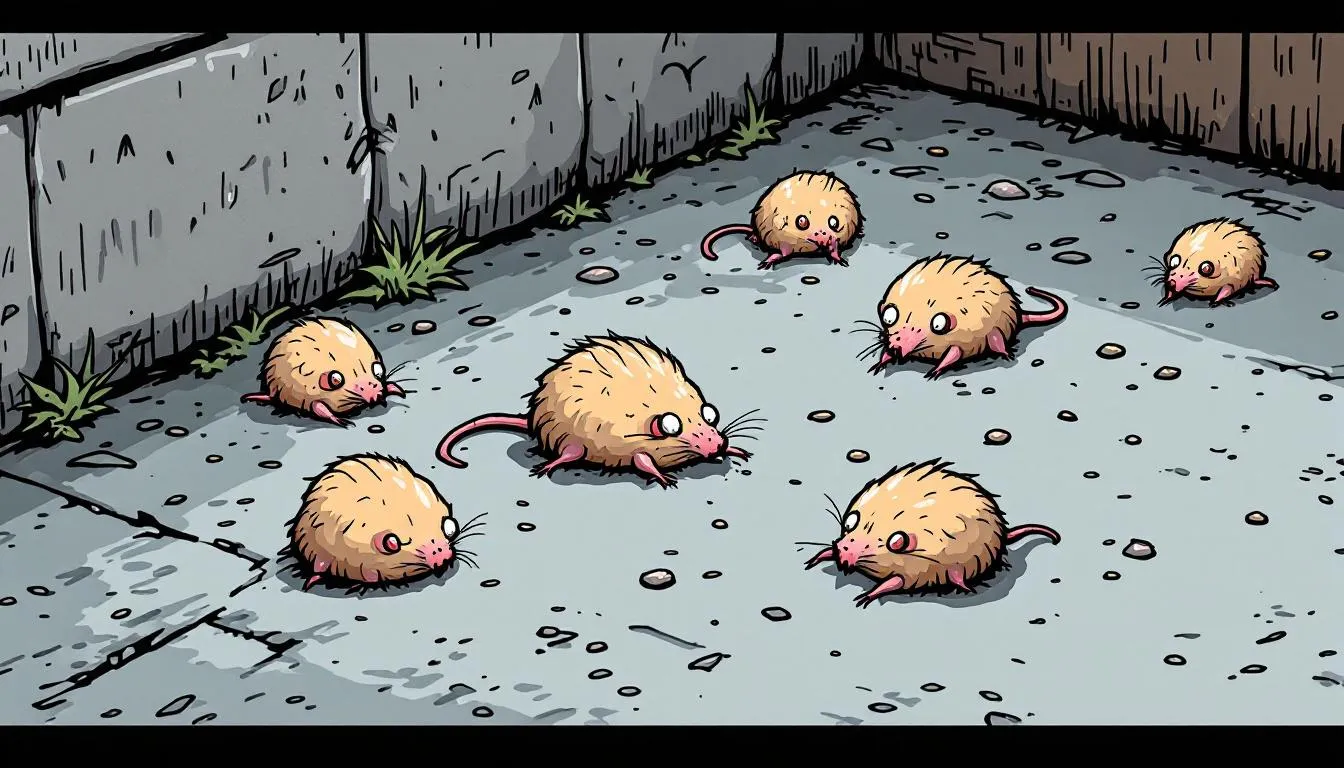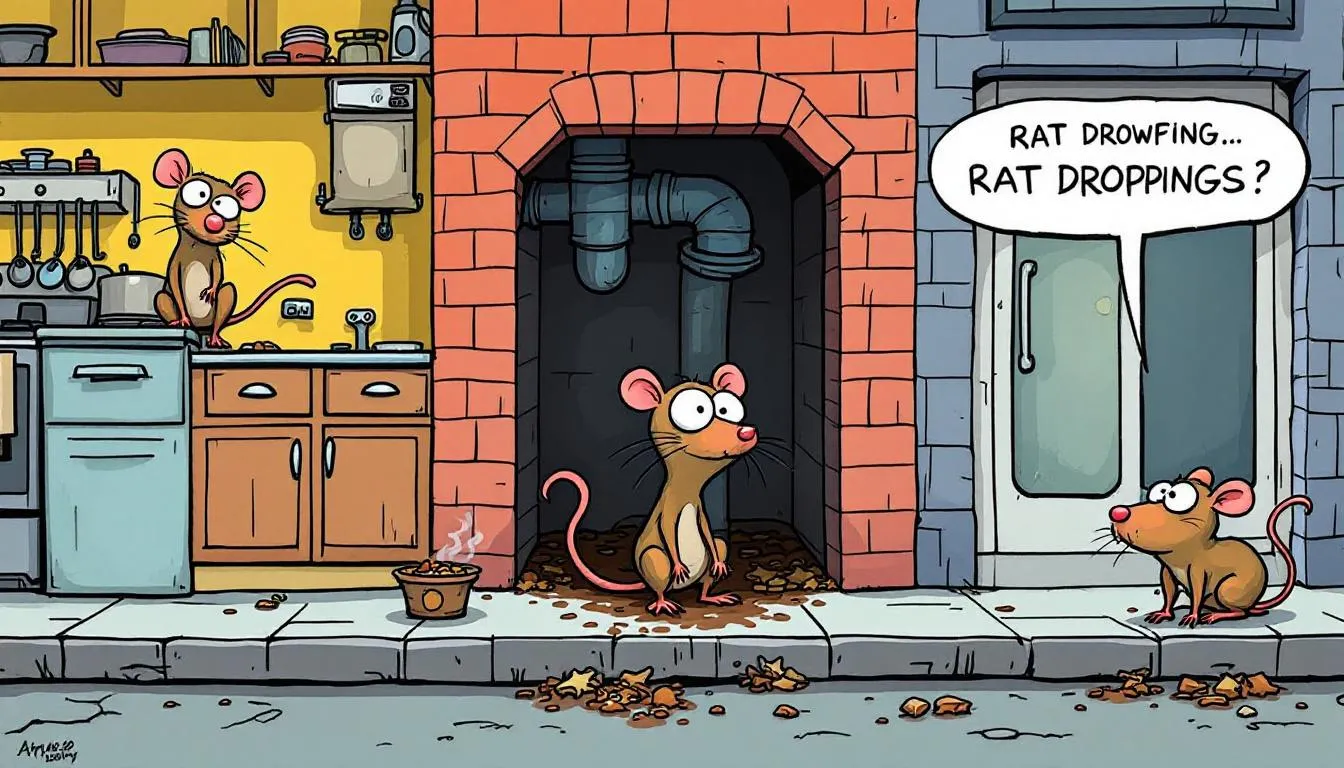Effective Rat Droppings

Effective Rat Dropping Identification and Cleanup Guide
If you’ve discovered rat droppings in your home, it’s crucial to know how to identify them, understand the health risks, and learn how to clean them up safely. This guide will provide all the essential information you need to manage this issue effectively.
Key Takeaways
Correct identification of rat droppings is crucial for effective rodent control, focusing on size, shape, and distribution to differentiate them from other pests.
Rat droppings pose significant health risks, transmitting diseases like leptospirosis and salmonella, making safe cleanup and proper sanitation essential.
Preventing future infestations requires sealing entry points, eliminating food sources, and considering professional pest control solutions for comprehensive management.
Identifying Rat Droppings

Rat droppings are small, dark, and cylindrical pellets, typically ranging from 1 to 2 centimeters in length. These droppings are often found scattered around the home rather than in a concentrated pile, a key characteristic that distinguishes them from the droppings of other household pests like squirrels. The appearance of rat droppings, rodent droppings, and rat feces can provide important clues about the type of rodent infesting your home.
Unlike mouse droppings, which are smaller and more spindle-shaped, rat droppings have the following characteristics:
More substantial in size
Blunt ends
Generally cylindrical form, though shape and size can vary slightly among species such as roof rats, Norway rats, and brown rats
Usually emit a mild but unpleasant odor, which becomes more noticeable when mixed with rat urine.
Correctly identifying rat droppings is crucial for effective rodent control. Misidentifying them as mouse droppings or those of other household pests can lead to incorrect treatment methods, allowing the infestation to persist. Paying close attention to the size, shape, and distribution of the droppings helps in accurately determining the type of rodent activity in your home.
Fresh vs. Old Rat Droppings
One of the key aspects of managing a rodent infestation is determining whether the droppings are fresh or old. Fresh rat droppings are dark, shiny, and moist, indicating recent rodent activity. These fresh droppings are a clear sign that the rats are currently active in the area, and immediate action is required to address the infestation.
In contrast, old droppings are dry, faded, and crumbly, often turning gray over time. Pressing down on the rat poop with a pencil can test their freshness; fresh droppings will be soft and pliable, while old ones will break apart easily.
Understanding the difference between fresh and old droppings can help you gauge the extent of the rodent infestation and the urgency of the situation.
Common Locations for Rat Droppings

Rat droppings are often found in clusters, indicating a larger presence of rodents in the area. These droppings can be found in various locations around your home, each providing clues about where the rats are nesting and feeding. Common places to find rat droppings include:
Countertops
Floors
Cabinets
Under appliances
Along baseboards.
The presence of rat droppings and urine is a strong indicator that rats are nesting and active in the area. Droppings in your kitchen or pantry suggest that rats are scavenging for food in these areas, potentially contaminating your food supplies. Finding droppings under appliances or in cabinets can indicate nesting sites, as these areas provide warmth and shelter.
If mice droppings reappear after cleaning, it confirms an active rodent infestation. This persistence indicates that the rats are still present and that more comprehensive measures may be needed to address the issue. Identifying these common locations and understanding their significance can help you target your rodent control efforts more effectively.
Health Risks of Rat Droppings

Rat droppings create unsanitary conditions and can spread multiple diseases, posing significant health risks to humans. These droppings are toxic and can transmit diseases through direct contact or by eating food contaminated and surfaces. The health risks associated with rat droppings can range from mild to life-threatening diseases, making it crucial to handle them with great care. Additionally, rat poop dangerous can lead to severe health consequences if not addressed properly. Contaminated food can also pose serious threats to health if not managed effectively.
Rodents are carriers of numerous diseases, including hantavirus, leptospirosis, and salmonella, which can be transmitted through their droppings, rodent urine, and saliva. Pregnant women are particularly at risk from exposure to rat droppings, as certain pathogens can lead to severe complications. To minimize health risks, it is essential to use proper sanitation measures when dealing with rat droppings, as rats carry hantaviruses and infected rodent populations can pose additional dangers.
To safely clean rat droppings, follow these steps:
Ventilate the area before cleanup to disperse potentially harmful particles and reduce the risk of inhaling contaminated dust.
Spray droppings with a disinfectant before cleanup to help reduce contamination.
Thoroughly wash your hands after cleaning rat droppings to eliminate any remaining contaminants.
Properly dispose of waste in sealed plastic bags to prevent exposure to disease.
Diseases Spread by Rat Droppings
Rat droppings can carry a variety of diseases, including leptospirosis, salmonella, tularemia, and roundworm. Humans can contract these diseases through direct handling of droppings or by inhaling contaminated spores. Exposure to rat droppings can lead to initial symptoms such as flu-like symptoms, fever, and body aches.
Leptospirosis, a bacterial disease caused by the Leptospira pathogen, can lead to severe complications if left untreated, including kidney and liver failure.
Other diseases include:
Salmonella, which can cause severe gastrointestinal distress.
Tularemia, which can result in fever, ulcers, and swollen lymph nodes.
Roundworm infections, which can lead to various health issues, including respiratory problems and organ damage.
Untreated exposure to these diseases can lead to serious complications, including lung or kidney failure and difficulty breathing. Recognizing the diseases spread by rat droppings and taking preventive measures is crucial for maintaining a healthy living environment.
Symptoms of Exposure to Rat Droppings
Exposure to rat droppings can lead to flu-like symptoms such as fever and muscle aches, often the early symptoms of infection. Pathogens like Leptospira found in rat droppings pose significant health risks, leading to conditions like leptospirosis. Symptoms vary widely in leptospirosis, but severe cases may result in kidney and liver failure, especially in pregnant women.
Inhaling particles from contaminated dust can also lead to respiratory issues and other complications. Therefore, recognizing these symptoms early and seeking medical attention is crucial to preventing severe health consequences from exposure to rat droppings.
Safe Cleanup Procedures
Safe cleanup of rat droppings is crucial to avoid dangerous disease transmission. Recommended precautions include:
Wear protective gear, such as rubber or plastic gloves
Wearing rubber gloves and a dust mask to protect yourself from harmful particles
Avoiding stirring up dust or debris, as this can increase the risk of inhaling contaminated particles.
Ventilating the area where the droppings are located disperses potentially harmful particles, reducing the risk of inhalation. Spray the droppings with a disinfectant solution, such as a mixture of household bleach and water, to kill any pathogens present on contaminated surfaces.
Use a paper towel to carefully pick up the droppings and dispose of them in a plastic bag. Seal the bag tightly and dispose of it in an outdoor trash bin. Afterward, thoroughly wash your hands with soap and water to remove any remaining contaminants. Additionally, consider using paper towels for this task to ensure cleanliness.
Step-by-Step Cleanup Guide
To safely clean up rat droppings, follow these steps:
Ventilate the area by opening windows and doors to minimize inhalation risks.
Wear rubber or plastic gloves and an N95 mask to protect yourself from harmful particles.
Spray the droppings with a bleach solution (1 part bleach to 10 parts water) to disinfect the area.
Use a paper towel to carefully pick up the droppings and dispose of them in a plastic bag.
Seal the plastic bag tightly and dispose of it in an outdoor trash bin.
Wash your hands thoroughly with soap and water after handling the droppings.
Following these steps will help ensure that you safely and effectively clean up rat droppings, minimizing the risk of disease transmission.
Preventing Future Infestations

Preventing future rodent infestations requires a proactive approach:
Seal gaps and openings in your home to block rodents from entering.
Use materials like steel wool to seal entry points, which can be particularly effective.
By eliminating potential entry points, you can prevent rats from accessing your home in the first place.
Eliminating food and water sources is another important step in rodent control. To do this effectively and get rid of potential attractants:
Keep your kitchen and dining areas clean and free of food debris.
Store food in sealed containers.
Make sure your trash cans are covered and regularly emptied.
Rats are attracted to areas where they can find sustenance, so following these steps is essential. Other animals, including other rats, rice rats, and more rats, live in environments that provide food and shelter. Glue traps can also be used to manage rat populations effectively.
Attics and basements are common nesting sites for roof rats and Norway rats, respectively. To manage rodent activity effectively:
Regularly inspect these areas for signs of rodent activity.
Take measures to eliminate potential nesting materials.
Consult pest control professionals for comprehensive exclusion strategies to manage severe rodent infestations.
Professional Pest Control Solutions
Hiring a wildlife control expert can be an effective way to manage rodent infestations and prevent future problems. These professionals are trained to identify rodent species and implement suitable removal methods. They can offer tailored pest control solutions that address the specific needs of your home.
Professional pest control services can provide comprehensive exclusion strategies, including sealing entry points, eliminating food sources, and removing nesting materials. By working with experts, you can ensure that your rodent problem is addressed thoroughly and effectively, reducing the risk of future infestations.
Summary
In summary, identifying rat droppings and understanding the health risks they pose are crucial steps in managing a rodent infestation. Recognizing the physical characteristics of rat droppings, knowing where to look for them, and differentiating between fresh and old droppings can help you assess the severity of the infestation.
Safe cleanup procedures and preventive measures are essential to protecting your health and home. By following the steps outlined in this guide and considering professional pest control solutions, you can effectively manage and prevent rodent infestations, ensuring a safe and healthy living environment.
Frequently Asked Questions
How can I tell if rat droppings are fresh or old?
You can determine if rat droppings are fresh or old by noting their appearance; fresh droppings are dark, shiny, and moist, whereas old ones are dry, faded, and crumbly.
What are the health risks associated with rat droppings?
Exposure to rat droppings can lead to serious health risks, including hantavirus, leptospirosis, and salmonella. It is crucial to handle any rodent contamination with caution to prevent these diseases.
Where are common locations to find rat droppings in my home?
You can typically find rat droppings on countertops, floors, cabinets, under appliances, and along baseboards. Addressing these areas promptly is crucial for preventing further infestation.
What safety precautions should I take when cleaning up rat droppings?
To safely clean rat droppings, it is essential to wear rubber or plastic gloves, an N95 mask, and ensure the area is well-ventilated. Disinfect with a bleach solution and dispose of the waste in sealed plastic bags.
How can I prevent future rodent infestations?
To prevent future rodent infestations, seal all gaps and openings in your home, eliminate available food and water sources, and consider hiring professional pest control services for effective exclusion strategies.



